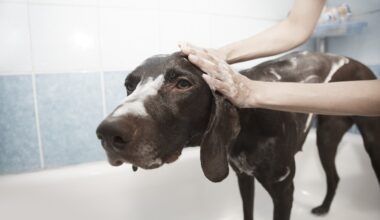Role of Behavioral Therapy in Treating Canine Separation Anxiety
Separation anxiety in dogs can be a challenging and distressing condition. Many dogs exhibit signs of anxiety when left alone, leading to destructive behaviors, excessive barking, and even self-harm. Recognizing the signs of separation anxiety is critical for pet owners. Symptoms can include whining, drooling, and attempts to escape. Behavioral therapy plays a vital role in addressing these issues. A skilled canine behaviorist can evaluate the dog’s specific problems and develop a tailored treatment plan. It’s essential to approach training calmly and consistently. Positive reinforcement techniques are often recommended, helping dogs associate alone time with rewards rather than fear. Solutions may also include gradual desensitization, where the dog gets accustomed to being alone for short periods, increasing the duration over time. Additionally, managing the environment can reduce anxiety triggers. Providing engaging toys or puzzles can keep a dog occupied while alone. Creating a comfortable space enhances the dog’s sense of security. In some cases, medication might be an option to support behavioral therapy, especially for severe cases. Combining therapy and training ensures a comprehensive approach to achieving a happier, more relaxed dog. This commitment brings hope for both dog and owner.
The link between anxiety and behavior is profound in dogs, and it’s essential to understand this relationship. Dogs suffer from separation anxiety when they feel abandoned, leading to emotional distress. Behavioral therapy addresses not just the symptoms but the underlying causes of anxiety as well. Strategies often include implementing a structured daily routine. This consistency helps dogs to feel secure and understand that their owners will return. Using training aids such as clickers can enhance learning experiences and reinforce positive actions. Owners should focus on gradual departures, allowing their dog to acclimate to their absence. This might include leaving the house for brief intervals and gradually increasing them. Ensuring the dog’s physical and mental needs are met can also mitigate anxiety. Regular exercise and stimulation are crucial in reducing excess energy that may translate into anxiety. Techniques such as crate training can provide dogs with a safe haven. Additionally, utilizing calming aids, such as pheromone diffusers or anxiety wraps, might help the dog relax during alone time. Keeping training sessions short and enjoyable prevents frustration for both dog and owner, solidifying a trust that enhances the bond. Therefore, patience and persistence are essential in treating separation anxiety.
Effective communication between dog and owner is crucial during behavioral therapy for separation anxiety. Dogs are incredibly perceptive to their owner’s cues and emotions. When owners exhibit stress, their dogs may mirror these feelings, exacerbating anxiety. Therefore, approaching training with a calm demeanor is essential for success. Techniques should involve clear and consistent commands, ensuring the dog understands expectations. Furthermore, practicing obedience training helps reinforce the owner as the leader. Trust is foundational in the human-canine relationship, which significantly impacts training outcomes. Behaviorists encourage creating a positive environment filled with affection, praise, and encouragement. Providing mental stimulation through obedience training and interactive games is beneficial. It engages the dog’s mind, distracting from the stress of loneliness. Socialization experiences with other dogs can also help reduce anxiety by promoting confidence. Gradually introducing new environments can prepare dogs for long-term independence. Engaging in groups or classes creates a supportive community aiding both the owner and the dog. The process may require time, but the bond will strengthen with consistent effort. Ensuring regular feedback from a professional can guide owners in adjusting their strategy to achieve long-lasting results. Ultimately, every effort improves the dog’s quality of life.
Integrating Professional Help and Resources
When tackling separation anxiety, integrating professional help can augment the effectiveness of therapy. Seeking the guidance of a certified dog trainer is available to pet owners who need additional support. Trainers skilled in behavioral therapy can offer valuable insights and tailored strategies. They can observe the dog and identify the specific triggers causing anxiety. Utilizing structured training sessions can help owners understand how to implement effective techniques. Literature on canine behavior can also serve as valuable additional resources. Books and online courses provide insights into methods and theories behind training approaches. Engaging with online forums can connect owners to a community facing similar challenges. Such platforms can also provide emotional support and practical tips. Understanding that behavioral therapy is not a one-size-fits-all solution is vital for continued progress. Results may vary depending on the dog, owner, and situation. Patience and perseverance are essential, as improvement might take time. Regular check-ins with a trainer can ensure that the direction of therapy remains appropriate. Utilizing a multifaceted approach can make a significant difference in overcoming separation anxiety and fostering healthy behavior in dogs.
Setting realistic expectations is crucial while navigating behavioral therapy for separation anxiety. Every dog learns and adapts at different paces, so progress may seem slow at times. Owners should celebrate small victories, reinforcing positive outcomes within the training process. The initial phases of behavioral therapy may prove particularly challenging, as dogs tend to react strongly to changes in routine. However, consistency remains key. Establishing a comprehensive plan with achievable goals encourages commitment throughout the journey. Engaging in regular training sessions, even brief ones, creates opportunities for success and learning. Acknowledging that setbacks may occur is vital. These moments can serve as learning experiences that highlight what needs adjustment in the training regimen. Moreover, monitoring the dog’s behavior during therapy gives vital insight into what works and what doesn’t. Professional trainers often recommend maintaining a journal to track progress, noting behaviors and triggers encountered day by day. This reflective practice can sharpen the owner’s understanding of their pet’s needs. Over time, these insights contribute to better communication and mutual understanding, further enhancing the bond between dog and owner, leading to a successful outcome in treating separation anxiety.
Long-Term Management Strategies
Managing separation anxiety in dogs often continues long after initial training concludes. Ongoing engagement with the dog through regular routines and activities reinforces learned skills. Owners can blend training exercises with play to maintain the dog’s interest. Enrichment activities such as puzzle toys help stimulate the dog’s mind while preventing boredom that could lead to anxiety. Additionally, periodically refreshing training techniques or introducing new challenges can keep dogs mentally engaged. Using technology, such as pet cameras, offers owners a way to monitor their dog during their absence. Observing the dog’s reactions can provide insights into any new triggers or areas needing attention. Establishing a support network, whether through professional trainers or fellow pet owners, can provide encouragement. Sharing experiences and advice can lead to new solutions for persistent issues. Gradually increasing the duration of separations makes the process more manageable. Furthermore, seasonal changes might require adapting routines or environments. Maintaining open communication with a vet regarding behavioral progress can aid in identifying any underlying health issues contributing to anxiety. Collectively, these long-term management strategies enhance the dog’s overall well-being and promote a harmonious relationship.
In conclusion, addressing separation anxiety through behavioral therapy requires commitment and collaboration between the owner and their dog. Utilizing a mix of training techniques, environmental adjustments, and ongoing support creates a robust framework for success. Owners need to appreciate individual differences in dogs, as experiences that work for one may not apply to another. By understanding their dog’s behaviors and reactions, owners enhance positive interactions that build trust. A supportive community engages both owners and dogs, offering resources to navigate challenges. Establishing practical routines and addressing separation issues gradually ensures a successful outcome. Professional guidance reinforces training while offering fresh perspectives, enabling informed adjustments. The treatment process may include setbacks, but patience and persistence will ultimately lead to positive transformations in behavior. Behavioral therapy’s ultimate aim is not just to reduce anxiety but also to foster a loving environment where dogs feel secure. As dogs thrive emotionally, they enrich our lives in countless ways. The journey of understanding and overcoming separation anxiety becomes a bonding experience. With dedication and care, every owner can help their dog achieve a happier, healthier life.
Lastly, the bond between dogs and their owners plays a pivotal role in battling separation anxiety. A strong, trusting relationship provides the foundation for successful behavioral interventions. Engaging in positive interactions and shared experiences fosters mutual understanding. Dogs primarily communicate through body language, which owners must learn to interpret correctly. Understanding stress signals can further aid in recognizing when anxiety escalates. Building confidence in a dog is achieved through consistent training sessions that reinforce their skills while reducing fears. Emotional support for canines also entails ensuring their basic needs are met, including physical health through regular veterinary care. Adequate nutrition, exercise, and mental stimulation create the environment dogs thrive in while combating anxiety. Providing a safe space for dogs during separations promotes a sense of security. Simple adjustments like using comforting scents, anxiety wraps, or calming music can be beneficial. In collaborating with professionals specializing in animal behavior, owners can gain valuable insights tailored to individual situations. Each dog is unique, which requires thoughtful, evidence-based approaches. By maintaining patience and compassion, owners not only help their dogs overcome separation anxiety but also strengthen their lifelong bond.


